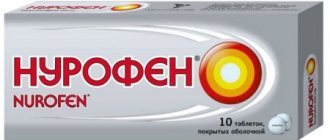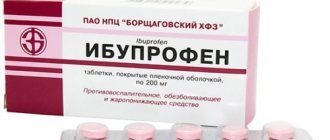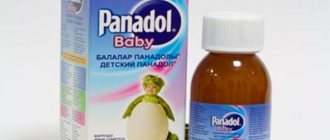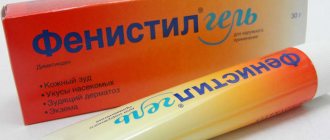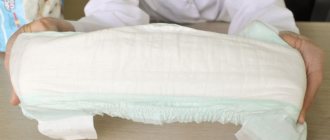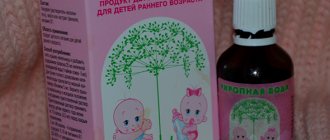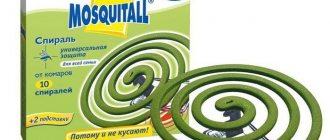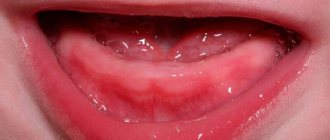Is it possible to take Cefekon and Nurofen at the same time? Colds often leave you bedridden, depress your mood, and worsen your overall health. And if a child is sick, then it is a hundred times worse, not only for the child, but also for his parents. Therefore, the pharmaceutical industry provides a wide range of different effective drugs against hyperthermia and inflammatory processes. The most common medications are Nurofen (Ibuprofen) and Cefekon (Paracetamol).
Tsefekon
The medicine is based on paracetamol, which reduces fever and relieves pain. But it does not fight inflammatory processes. The effect of the medicine is up to 4 hours. It has been used in medical practice for more than 60 years and has proven itself well.
Release form
Rectal suppositories. They are white in color and have no odor. The package contains 10 suppositories (2 plates of 5 pcs.). The content of paracetamol varies (50, 100, 250 mg) depending on the age of the patient. Can be used from 3 months to 12 years of age.
When to use
In what cases is it recommended to use the drug:
- For pain syndrome: teething, headache, ear pain, and so on.
- It is recommended to place it on the first day after heavy vaccinations in order to alleviate the child’s condition and prevent complications.
- To reduce body temperature during illness.
- Relieves muscle pain and pain due to injury.
When using it, it is important to monitor after what period of time it is recommended to re-introduce the suppository.
When use is prohibited
Like all medicines, Cefekon has contraindications:
- Paracetamol is contraindicated (intolerance).
- Liver diseases accompanied by dysfunction of the organ.
- Age up to 3 months and low weight (less than 5 kg).
- Problems with the rectum (bleeding or inflammation).
Conditional contraindications:
- Blood clotting is impaired.
- Chronic liver diseases.
- Blood diseases.
How to use
The medicine is injected into the rectum. If there is no urgent need for urgent use, then it is better to administer the suppository after the bowel movement.
Depending on age and weight, the dosage of the drug changes.
| Age | Child's weight (kg) | Dosage in mg | Permissible dose per day (mg) |
| 3 months | 5 | 50 | 150 |
| 3 – 12 months | 6 — 9 | 100 | 300 |
| 13 years | 9 — 13 | 200 (take 2 suppositories of 100 mg each) | 600 |
| 3 – 10 years | 13 — 30 | 250 | 700 — 1000 |
| 10 - 12 years | 30 — 36 | 500 (2 Suppositories of 25 mg) | 1500 |
To prevent the medicine from harming the liver, suppositories should be administered at intervals of at least 4 hours. To reduce the temperature, the permissible rate of use is up to 3 days. To relieve pain symptoms, no more than 5 days. If continued treatment is required, then after consultation with a pediatrician, another drug is selected.
Possible side effects
May occur with incorrect dosage of the drug.
- Problems with the digestive tract: abdominal pain, nausea, enlarged liver.
- Frequent and loose stools.
- Problems with hematopoiesis, anemia.
- Drowsiness, lethargy, low blood pressure.
- Allergic rashes.
If at least one symptom appears, the drug is discontinued.
In case of an overdose of the drug, the above symptoms appear. Consultation with a pediatrician is required. An overdose often occurs if drugs containing paracetamol are taken together. In case of sudden side effects, you must call an ambulance.
One of the advantages of the drug is that the medicine bypasses the liver, unlike tablets. Causes less harm to the digestive tract.
Combined use of Cefekon and Nurofen
Can Cefekon and Nurofen be taken together? Due to the fact that Cefekon reduces temperature well for colds, but if hyperthermia is caused by any bacterial infection, then this medication is not effective enough. In this case, after Cefekon you can give Nurofen, but only at intervals of several hours. Taking each drug with an interval of 8 hours, they alternate.
Taking these two drugs together is not recommended as this may increase the risk of side effects . At the moment, world pharmacologists are making attempts to create a drug based on the active substances ibuprofen and paracetomol, the effect of which will be aimed at relieving pain. But so far such medications are at the stage of clinical trials.
Experts do not recommend giving Nurofen and Cefekon to a child at the same time to bring down the temperature below 38 degrees, due to the fact that a body temperature of up to 38 indicates that the small body is fighting the infection on its own.
Nurofen
The medicine is based on ibuprofen. The product perfectly fights fever, pain and inflammatory processes. Suitable for use from 3 months of age. Mothers have been successfully using the product for more than 4 decades.
Release form
The medicine is available in various forms:
- Coated tablets. effervescent, rapidly dissolving tablets. They contain 200 mg of ibuprofen.
- Rectal suppositories. They contain 60 mg of ibuprofen.
- Suspension (with strawberry or orange flavor and aroma). 5 ml of the drug contains 100 mg of ibuprofen.
- Painkillers gels and ointments (per 100 g of ointment/gel there are 5 g of ibuprofen).
In what form to choose a drug depends on the course of the disease. And how does the child take medications? If this is a problem, then candles are the best option.
When to use
List of diseases when the medicine is used:
- Colds and infectious diseases.
- Headache, ear and toothache.
- To reduce pain from injuries.
- To relieve muscle pain.
When is it prohibited to take the drug?
There are a number of restrictions:
- Disorders of the gastrointestinal tract, especially peptic ulcers.
- Blood diseases.
- Ibuprofen intolerance.
- High blood pressure.
- Kidney and liver diseases.
- Visual impairment.
How to use
The drug is taken based on the weight and age of the child.
| Age | Child's weight (kg) | Dosage in mg | Permissible dose per day (mg) |
| 3 months | 6 | 50 | 150 |
| 3 – 12 months | 6 — 9 | 50 | 200 |
| 13 years | 9 — 13 | 150 | 400 — 900 |
| 3 – 10 years | 13 — 30 | 200 | 900 |
| 10 - 12 years | 30 — 36 | 200 — 400 | 1200 |
The daily dose should not be exceeded. If the effect of the medicine does not last long, you need to change the medicine. Oral administration is carried out during meals. This way the digestive tract is less irritated. The maximum duration of action of the drug is 6-8 hours.
Side effects
They are quite rare. Sometimes it was noted:
- Decreased appetite.
- It can provoke the onset of erosion in the gastrointestinal tract.
- Headache, overexcitability, dizziness.
- Impaired heart function, increased blood pressure, shortness of breath.
- Allergy.
- Impaired kidney function.
- Problem of hematopoiesis, anemia.
- The appearance of swelling.
In case of overdose, the effect can be any. It is advisable to go to the hospital immediately.
Alternation of drugs
If you have a fever or severe pain, your doctor may recommend taking Nurofen and Cefekon alternately. Ibuprofen and paracetamol are 2 active ingredients that WHO recommends to use to relieve pain and lower fever in children. If one of the selected drugs helps well, then it is not necessary to change it.
Cefekon and Nurofen should be alternated in cases where the effectiveness of each of them is low. But you need to understand that at high temperatures you should not expect to see 36.6°C on the thermometer.
Is it possible to alternate Nurofen and Cefekon? It is worth using ibuprofen and paracetamol if the temperature is above 38°C . But it is not necessary to give these drugs at the same time. Doctors say that you should take at least 2-3 hours between doses. During this time, the maximum concentration of the main active ingredient Nurofen or Cefekon in the blood is reached. If you cannot withstand even a 2-3 hour break between the rise in temperature, then it is better to call an ambulance.
Sources:
Vidal : https://www.vidal.ru/drugs/nurofen GRLS : https://grls.rosminzdrav.ru/Grls_View_v2.aspx?routingGu >
Found a mistake? Select it and press Ctrl + Enter
Often parents are faced with situations where antipyretics and painkillers relieve unpleasant symptoms only for a couple of hours. But you cannot give the same drug too often, so the question arises of how to alternate Nurofen and Cefekon.
Features of using Nurofen
For high fever or pain, children over 3 months of age are allowed to give Nurofen. This is an ibuprofic drug that has a pronounced analgesic and antipyretic effect. It belongs to non-steroidal anti-inflammatory drugs.
To calculate how much syrup you can drink per day, you need to know that each ml contains 20 mg of ibuprofen. And per day it is allowed to consume 20-30 mg of ibuprofen per kg of body weight.
The maximum concentration of ibuprofen in the blood is observed 45 minutes after consuming the drug. If taken after or during meals, the time increases to 1-2 hours. The duration of exposure depends on the condition of the small patient. For some, more than 8 hours pass before the next rise in temperature after taking Nurofen, while for others it begins to rise again after 2-3 hours.
You should not take Nurofen more often than once every 8 hours. If symptoms appear earlier, it is necessary to alternate medications.
Cefekon is available in the form of suppositories. The main active ingredient is paracetamol. The popular drug Panadol is made from the same substance. Each Tsefekon suppository can contain from 50 to 250 mg of paracetamol, depending on the chosen dosage.
Cefekon is prescribed to children aged 3 months to 12 years. The dose is calculated based on the following data:
- For every kg of a child’s weight, 60 mg of paracetamol per day is required;
- The daily amount is divided into 4 doses per day;
- Tsefekon suppositories are inserted no more than once every 6 hours.
It is not advisable to take paracetamol-containing drugs for more than 4 days in a row without medical supervision.
If you have a fever or severe pain, your doctor may recommend taking Nurofen and Cefekon alternately. Ibuprofen and paracetamol are 2 active ingredients that WHO recommends to use to relieve pain and lower fever in children. If one of the selected drugs helps well, then it is not necessary to change it.
Cefekon and Nurofen should be alternated in cases where the effectiveness of each of them is low. But you need to understand that at high temperatures you should not expect to see 36.6°C on the thermometer.
Is it possible to alternate Nurofen and Cefekon? It is worth using ibuprofen and paracetamol if the temperature is above 38°C . But it is not necessary to give these drugs at the same time. Doctors say that you should take at least 2-3 hours between doses. During this time, the maximum concentration of the main active ingredient Nurofen or Cefekon in the blood is reached. If you cannot withstand even a 2-3 hour break between the rise in temperature, then it is better to call an ambulance.
Found a mistake? Select it and press Ctrl + Enter
Is it possible to take Cefekon and Nurofen at the same time? Colds often leave you bedridden, depress your mood, and worsen your overall health. And if a child is sick, then it is a hundred times worse, not only for the child, but also for his parents. Therefore, the pharmaceutical industry provides a wide range of different effective drugs against hyperthermia and inflammatory processes. The most common medications are Nurofen (Ibuprofen) and Cefekon (Paracetamol).
What is the difference
These medicines also have differences.
| Tsefekon | Nurofen |
| Lower price | Available in different forms, you can choose the appropriate option |
| Not suitable for diarrhea | Has anti-inflammatory properties |
| Begins to act after 30 minutes | Tablets and syrup begin to act after 20 minutes, suppositories after 10 minutes |
| Reduces fever better (due to paracetamol) | The effect lasts longer |
| Better relieves toothache | |
| Can be given from 5 years old | Can be given from 6 years of age |
Dosage forms of Nurofen and Tsefekon
Medicines Nurofen and Tsefekon are available in different dosage forms. The patient will choose the most convenient dosage form for himself or his child. For the youngest patients, drugs are available in the form of suppositories and sweet syrups.
Nurofen and Tsefekon suppositories are available in different dosages, that is, the suppositories may contain different amounts of the active substance. The syrups differ only in flavor additives (orange, strawberry), and the dosage is measured with a measuring spoon. Also, these dosage forms have a shorter onset of action - the active substance is quickly absorbed through the mucous membranes of the rectum and spread throughout the body through the bloodstream.
Tsefekon and Nurofen syrups are also quickly absorbed through the walls of the stomach, and flavoring additives are designed to give a taste more attractive to the child. Adult patients prefer to take medications in the form of tablets, which may also differ in the concentration of the active substance.
Which medicine is better to choose?
When choosing a medicine, you need to know whether the child has an intolerance to paracetamol or ibuprofen. If not. You can see this by the baby’s reaction.
- Perhaps Cefekon suppositories will be much better at reducing fever and relieving pain than Nurofen. It happens.
- Doctors recommend Cefekon for very young children, and Nurofen for older children. For example, Tsefekon suppositories are allowed to be used by children from the first month of life, but under the supervision of a doctor. Nurofen can be taken strictly from 3 months.
- If the disease is accompanied by an inflammatory process, then Nurofen will be more effective.
- Nurofen comes in different forms, so there are many to choose from to persuade your child to take the medicine.
Combining these two medications is not recommended . But if there is a need and the pediatrician has approved the combination, then it is imperative to maintain an interval of at least 4 hours between taking medications.
When choosing a medicine, it is better to be guided by the effect achieved (if the medicine was taken before) and the course of the disease. The main thing is to have a result. Both medications have proven themselves to be excellent.
Medicine and healthComment
Is it possible to alternate two drugs?
For prolonged fever, the doctor allows taking Cefekon after Nurofen, since the medications contain different substances. Candles can be replaced with Panadol. If one drug does the job well, there is no need to alternate medications; you can be treated with one.
Doctors recommend lowering the temperature if the thermometer rises above 38 degrees; if the readings are low, you need to give the body the opportunity to cope with the disease on its own. You should not give Nurofen and Cefekon syrup at the same time; there should be a gap between antipyretic treatment. The minimum interval between taking different medications is 2-3 hours. If the fever persists after using any of the medications, the best option is to call an ambulance.
If you don’t know what to give - Cefekon D or Nurofen suppositories for children, you need to consider:
- Age. Syrup is allowed for newborns from 3 months; suppositories, according to indications, are allowed from a month.
- Sensitivity to components. Each patient has different sensitivity to medications; for some, Paracetamol helps; some children manage to reduce their fever after taking Ibuprofen.
- Form of the drug. It is easier for children to take the suspension with plenty of water. For vomiting, it is recommended to use Cefikon suppositories; for diarrhea, syrup.
- Budget. The cost of syrup is higher than Tsefekon.
Nurofen and Cefekon are two drugs that are the most effective in the fight against fever and pain, approved by WHO. It is difficult to answer which is better - you need to judge the patient’s condition and sensitivity to different components.
Often parents are faced with situations where antipyretics and painkillers relieve unpleasant symptoms only for a couple of hours. But you cannot give the same drug too often, so the question arises of how to alternate Nurofen and Cefekon.
Side effects
The immune system
Anaphylactic shock, possible development of Quincke's edema, redness, rash, swelling of the skin, erythema, tissue necrolysis due to the action of the drug.
Blood-forming organs
Leukopenia, hemolytic anemia, sulfhemoglobinemia, neutropenia, thrombocytopenia, methemoglobinemia, characterized by shortness of breath, severe cyanosis and pain in the heart.
Respiratory system
Bronchospasm may develop in case of hypersensitivity to non-steroidal anti-inflammatory drugs.
Gastrointestinal tract
Nausea, vomiting, pain in the stomach, impaired liver function, as a rule, jaundice does not develop.
In case of impaired glucose tolerance, hypoglycemia may develop, including coma.
Local side effects
Irritation at the injection site (anus, rectum).
If any negative symptom occurs, you must immediately stop taking the drug and seek advice from a pediatrician.
special instructions
Treatment of young patients requires maximum care and responsibility. In order not to cause harm to the baby, it is necessary to adhere to the recommendations of the attending physician and take into account special instructions that relate to the use of rectal suppositories
The drug should not be used if the child’s weight does not exceed 5 kg. The risk of side effects from internal systems or organs is much higher in premature babies. This means that treatment should be carried out under the supervision of a specialist.
Ibuprofen can be used as a drug substitute in cases where it is not effective enough. Replacement of drugs is carried out with the permission or under the supervision of a qualified specialist.
With increased caution, suppositories are prescribed to children who have been diagnosed with liver disorders. If during the course of treatment a deterioration in the condition of the organ occurs, you must notify the doctor and stop using this drug.
The speed of psychomotor reactions and the state of the central nervous system do not change under the influence of the medication, provided that the dosage was calculated correctly and the patient followed all the specialist’s recommendations. If there is a need to use suppositories for longer than 5 days, it is necessary to monitor liver function. Only a doctor can extend the course of treatment, taking into account the patient’s condition.
special instructions
If there is no result of therapy with Cefekon D within three days, it is necessary to undergo a re-examination at a medical institution. You cannot combine suppositories with medications that contain paracetamol. Violation of this rule may provoke overdose symptoms.
If it is necessary to supplement Cefekon D with other drugs, only a qualified specialist should draw up a course of therapy.
Special instructions when using candles are the following:
- It is recommended to use suppositories after bowel movements (if bowel movement occurs after a short period of time after using the suppository, then therapy may be significantly reduced);
- long-term use of suppositories can change some blood parameters (laboratory tests are recommended to be taken again some time after the course of treatment);
- Cefekon D should not be combined with barbiturates, tricyclic antidepressants, phenylbutazone and phenytoin;
- it is necessary to use suppositories for the treatment of children whose body weight differs from the norm (including babies born prematurely) only under the supervision of a specialist;
- prolonged use of suppositories can cause toxic effects on the child’s liver;
- It is prohibited to use drugs containing ethanol during suppository therapy;
- a combination of antipyretic suppositories with Ibuprofen or Nurofen syrups (suspension) is acceptable (the effectiveness of therapy will improve, but the simultaneous use of these drugs must be agreed with a specialist);
- if, after using the drug, the child’s blood pressure is disturbed, dizziness or general weakness of the body appears, then such conditions indicate an excess of the dosage or the presence of individual intolerance to the components included in the suppositories;
- a serious symptom indicating a child’s intolerance to the drug is an attack of uncontrollable vomiting (if such a condition exists, the baby must be shown to a specialist);
- simultaneous use of Cefekon D with Cimitidine agents can reduce the effectiveness of therapy and cause toxic effects on the child’s body;
- suppositories enhance the effect of drugs from the group of anticoagulants.
